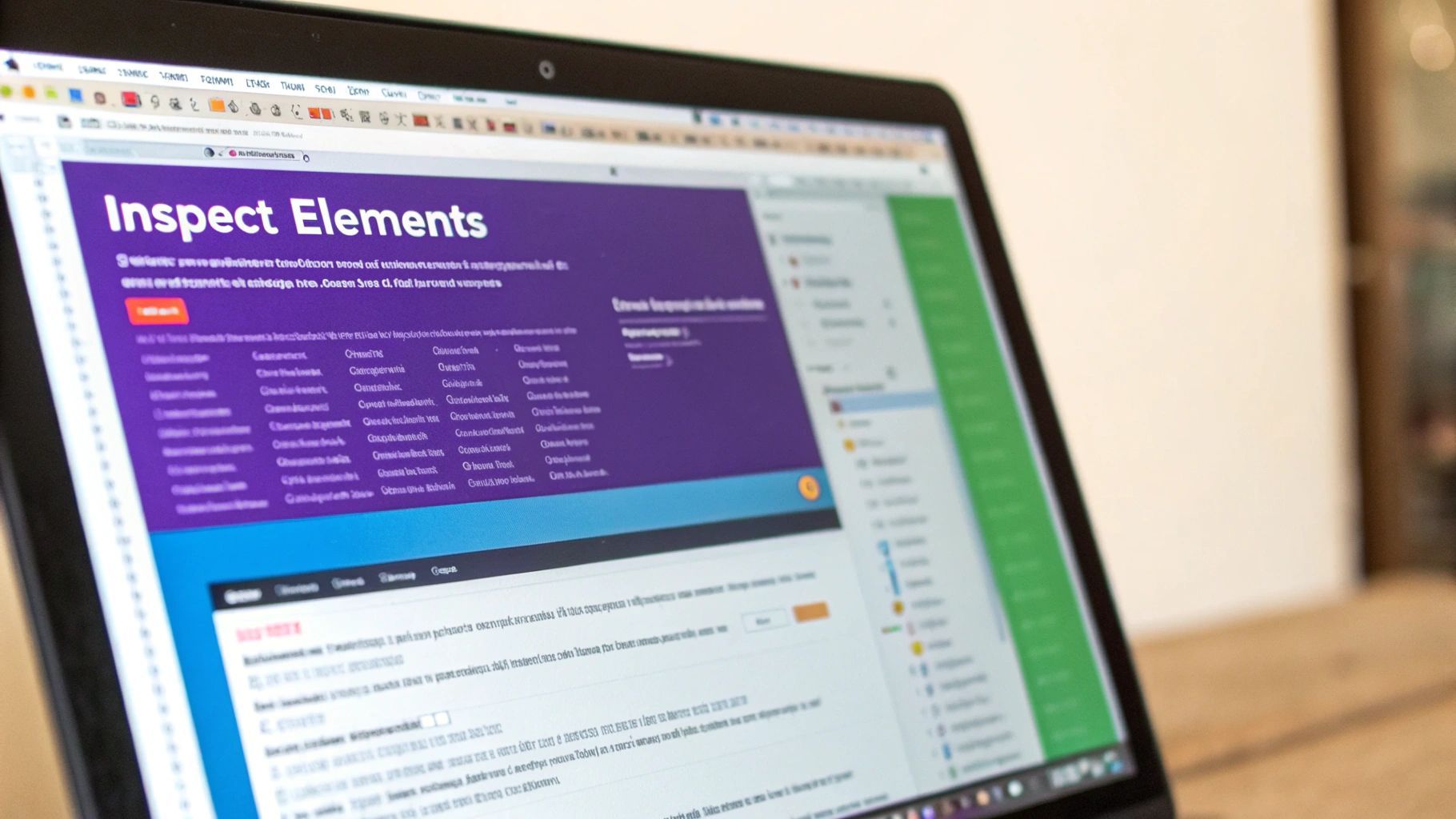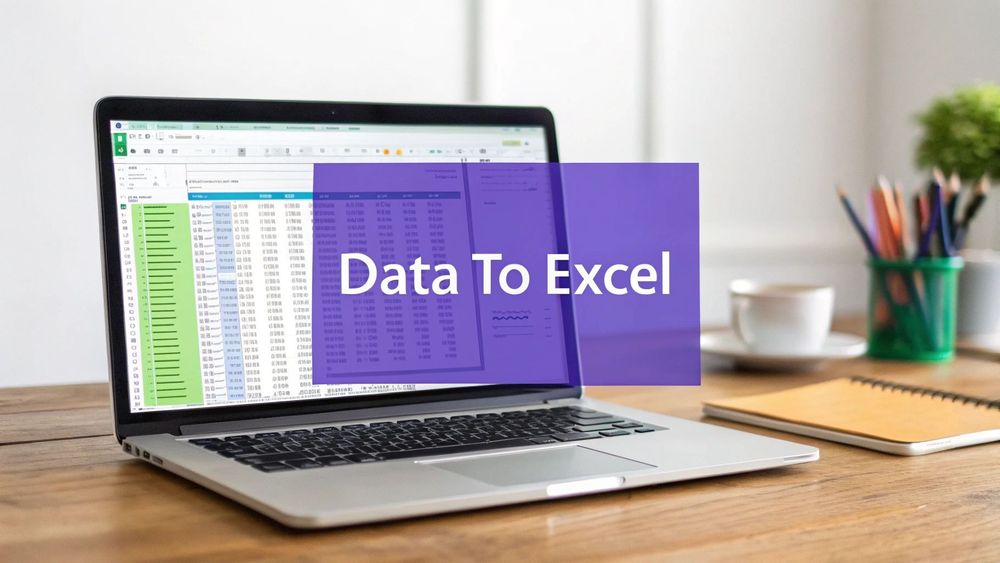Trying to get valuable data from a website like LinkedIn into a usable Excel sheet is a daily challenge for many professionals, but it doesn't have to be a nightmare. The old-school approach of manual copy-pasting or getting tangled in complex code is thankfully obsolete. The modern, and frankly much smarter, answer is a no-code scraping tool. This kind of tool automates the entire process, letting you pull accurate data in seconds, not hours, and focus on what you do best.
Why Automated Data Scraping Is a Game-Changer
If you're a busy recruiter or a sales professional, you know that time is your most valuable asset. The traditional way of building lead lists or candidate pipelines meant blocking off an entire afternoon just to manually transfer information from a website into a spreadsheet. That process isn't just painfully slow; it's practically guaranteed to have human errors, leading to bad contact details and missed opportunities.
This manual, mind-numbing work is exactly why a new approach is so critical. Instead of seeing data collection as a chore, you can flip the script and turn it into a real strategic advantage. Modern tools do the heavy lifting for you, so you can focus on what actually moves the needle: closing deals and hiring top-tier talent.
The Problem with the Old Way
Let's be honest, manual data entry is a massive productivity killer. You've probably run into these roadblocks before:
- It's a time sink: Hours get torched on copy-paste tasks that an automated tool could knock out in a few minutes.
- Errors are inevitable: Simple typos or formatting mistakes can make your data totally useless, costing you real leads.
- It just doesn't scale: You can't realistically build a list of 500 prospects by hand. As your needs grow, manual methods quickly become impossible.
The demand for better solutions is blowing up. The web scraping market is on track to hit about USD 1.03 billion in 2025 and is expected to nearly double to USD 2.00 billion by 2030. It's clear that businesses are catching on to the power of automated data.
A Smarter Way to Build Your Lists
No-code tools like ProfileSpider make these problems disappear. They work like a personal data assistant, intelligently spotting and extracting the information you need from any website with just a single click.
Picture this: you're a recruiter on a LinkedIn search results page looking for software engineers. Instead of squinting at the screen and retyping everything, you instantly capture the names, titles, and company details of every single professional on that page. That's the power of automation.

This shift from manual to automated scraping is more than just a convenience—it’s a fundamental change in how you work. It frees up your time, guarantees your data is accurate, and empowers you to build comprehensive lead and candidate lists faster than ever. That efficiency leads directly to better business outcomes, whether that's a packed sales pipeline or a shorter time-to-hire.
If you're curious to see just how easy it is, you can check out our simple guide on how to test a profile scraper.
Data Scraping Methods at a Glance
Here’s a quick comparison of the different ways to get website data into Excel, highlighting the pros and cons for busy professionals.
| Method | Time Investment | Technical Skill Required | Best For |
|---|---|---|---|
| Manual Copy-Paste | High | None | Very small, one-off tasks (e.g., less than 10 contacts). |
| Custom Coding (Python, etc.) | Very High | Advanced | Developers building highly specific, complex scraping solutions. |
| No-Code Scraping Tool | Very Low | None | Sales pros, recruiters, and marketers needing fast, accurate, and scalable data extraction without any coding. |
Ultimately, the right tool depends on your goals, but for most professionals who need to build lists efficiently, a no-code solution is the clear winner.
The Traditional Method: The Manual Grind
Before we jump to the modern solution, let's walk through the traditional way to scrape data from a website into Excel. This manual process is what many professionals still fall back on, and understanding its pitfalls highlights why automation is so crucial.
Let's use a real-world example: A sales professional needs to build a prospect list of 50 marketing managers in New York City from a professional networking site.
Here's the step-by-step manual workflow:
- Navigate to the Website: Open your browser and go to the target website (e.g., an industry directory or LinkedIn).
- Perform a Search: Use the site's search function to find "Marketing Managers" located in "New York City."
- Open Excel: Launch a new, blank spreadsheet.
- Create Columns: Manually set up your columns: "Full Name," "Job Title," "Company," "Location," and "Profile URL."
- Copy and Paste: Go back to your browser. Highlight the first person's name, copy it (
Ctrl+C), switch back to Excel, and paste it (Ctrl+V) into the "Full Name" column. - Repeat, Repeat, Repeat: Continue this process for the job title, company, and location. Then, right-click their name to copy the link to their profile and paste that into the "Profile URL" column.
- Do It All Again: Move to the second person on the list and repeat the entire copy-paste cycle for every field. You'll do this 50 times to complete your list.
This constant back-and-forth doesn't just invite mistakes; it leads to serious burnout and crushes the motivation of your most skilled people.

The High Price of Human Error
Beyond the sheer time sink, this process is a breeding ground for human error. One tiny typo in an email address or a single wrong digit in a phone number can make a hot lead completely worthless. Studies have shown that even with the most diligent effort, manual data entry error rates can hover around 4%. For a list of 100 contacts, that means four of them are probably wrong right from the start.
These small mistakes snowball over time, leading to failed outreach campaigns and a contact database you just can't trust. The bottom line is that manual processes are unsustainable for any professional who's serious about growth. They're slow, inaccurate, and demoralizing, creating a bottleneck that directly impacts your bottom line.
The Modern Method: One-Click Scraping with ProfileSpider
Now, let's see how ProfileSpider, a modern, no-code AI profile extraction tool, transforms that entire workflow into a single click. It’s designed specifically for recruiters and sales teams who need accurate data fast, without the technical drama.
Let's take the same scenario: building a list of 50 marketing managers in New York City.
The One-Click Workflow
The real magic of a tool like ProfileSpider is its simplicity. There's no complicated setup or confusing configuration. The whole thing is intuitive and lives right inside your browser.
Here’s the breakdown:
- Install the Extension: Add the ProfileSpider extension to your Chrome browser in under a minute.
- Go to the Search Results: Navigate to the exact same search results page you used in the manual method.
- Click "Save Profiles": Open the ProfileSpider extension and click the “Save profiles” button.
That's it. ProfileSpider’s AI engine instantly analyzes the page, identifies all 50 profiles, and extracts their names, job titles, companies, and locations into a structured list within the extension. The entire multi-hour manual chore is done in about five seconds.
This visual really captures how seamless the journey is, taking messy web data and turning it into a structured Excel file without any manual work.

As the infographic shows, ProfileSpider turns what used to be a complex, technical task into a straightforward, automated export. Your data becomes immediately usable.
Turning Raw Data Into Actionable Intelligence
Once the data is captured, it’s all stored locally in your browser, which means your information stays private. From there, you can start organizing contacts into lists, adding custom tags (think "top candidate" or "Q4 lead"), and jotting down notes right inside the tool.
When you're ready to export, it’s just as easy.
You can download your organized data as a clean CSV or a formatted Excel file, perfectly prepped for import into your CRM or Applicant Tracking System (ATS). This entire workflow gives you total control over your data, all without ever having to leave your browser. It's not just about web scraping, either. Tools like specialized bank statement extraction software are also tackling the headache of manual data entry by automating the conversion of financial PDFs into clean Excel data.
The real win here is turning a multi-hour manual chore into a process that takes less than five minutes. This isn't just a minor improvement; it's a massive productivity leap that frees you up to focus on outreach and building relationships instead of being a data entry clerk.
By using a tool built for exactly what you need—scraping profiles from LinkedIn, Facebook, GitHub, and more—you can build higher-quality lists, jump on opportunities faster, and ultimately, get better results.
Making Your Scraped Data Actually Useful in Excel
Let's be honest, pulling a bunch of data is only half the battle. The real magic happens when you turn that raw information into something you can actually use. Once you've used a tool like ProfileSpider to get that data into Excel, a few quick tweaks can transform a messy spreadsheet into a goldmine for your next sales or recruiting push. And no, you don't need to be an Excel wizard to do it.
For anyone in sales or recruiting, the name of the game is clarity and speed. That fresh export of contacts is a fantastic start, but it only becomes a powerful asset once you clean it up. Taking a few minutes to organize everything now makes importing into your CRM or Applicant Tracking System (ATS) a breeze and keeps your systems from turning into a chaotic mess.
Quick Wins to Organize Your Data
With your new list open in Excel, there are a couple of things you can do right away to make it infinitely more useful. These aren't complicated formulas, just practical steps to bring some order to the chaos.
- Filter and Sort Your Lists: Need to zero in on candidates in a specific city? Or maybe you want to find leads with a certain job title? Use Excel's Sort & Filter feature. In just a couple of clicks, you can arrange your entire sheet to show you the most promising contacts first, making it way easier to plan your outreach.
- Remove Duplicate Entries: It’s almost guaranteed that you'll have the same contact show up more than once, especially if you're combining data from a few different scrapes. Just head over to the Data tab and hit the Remove Duplicates function. This instantly tidies up your list, saving you from the embarrassment of contacting the same person twice and keeping your database clean.
Getting these simple things done first means you're starting off with a focused, high-quality list right from the get-go.
The goal here is to move from a raw data dump to a strategic tool. When you clean and organize your Excel file, you're not just tidying up a spreadsheet—you're building a solid foundation for your entire outreach process. Every contact becomes relevant and ready for action.
Prepping Data for Your CRM or ATS
This is the final, and most critical, step before you can push your list into another system. Most CRMs and ATS platforms are picky; they need specific column headers to map the data correctly (think "First Name," "Last Name," "Email Address").
Before you even think about importing, take a minute to rename your columns in Excel so they perfectly match the fields in your CRM or ATS. It’s a simple drag-and-drop or rename action that prevents a world of hurt later. Trust me, it saves you from the soul-crushing task of manually fixing hundreds of entries after a failed import. A clean, well-organized spreadsheet is your ticket to unlocking the true potential of the data you worked so hard to get.
Trying to pull data from a modern website straight into Excel can feel like trying to catch smoke with your bare hands. It’s a frustrating experience. Websites aren't the simple, static pages they used to be; they're now armed with defenses that bring basic scraping methods to a screeching halt.
If you're a professional who relies on this data, you've probably hit these walls before. Understanding what's really going on is the first step to getting past them.
The most common culprit is dynamic content. Think about a site that uses JavaScript to load contact info, product prices, or job listings after the main page has already appeared. A simple scraper only sees the initial code and completely misses the crucial data that pops in a second later. This is exactly why a manual copy-paste sometimes grabs nothing, or why a basic tool spits out a totally empty spreadsheet.
Then you have sites that demand a login, like LinkedIn. These platforms are essentially walled gardens, built to protect user data and shut down any automated access. If you try to scrape these pages with a generic tool, you’ll almost always get blocked immediately. They're incredibly good at spotting activity that doesn't look human.
Getting Around Anti-Scraping Defenses
On top of that, websites are actively fighting back with anti-scraping measures. This can be anything from a simple CAPTCHA that needs a human touch to more sophisticated systems that actually track your mouse movements and browsing patterns to tell if you're a real person or a bot.
Once a scraper is flagged, the site can block its IP address. Just like that, you're shut out, and any more attempts to get the data you need are dead in the water.
For anyone who isn't a developer, these defenses create a cascade of problems:
- You get incomplete data. The Excel file you worked so hard to get is full of holes because the scraper couldn't deal with the dynamic content.
- You get blocked. After just a few tries to gather profiles, you're locked out of a critical source like LinkedIn.
- Things constantly break. The script or tool that worked perfectly yesterday is useless today because the website tweaked its code or beefed up its security.
This is precisely where a tool built for the job, like ProfileSpider, changes the game. It’s been engineered from the ground up to handle these modern complexities for you, quietly and effectively. Its AI-powered engine renders JavaScript, manages login sessions securely, and mimics real human browsing to fly under the radar. It turns what was an impossible, technical nightmare into a single click.
Staying Compliant in a Heavily Regulated World
Beyond the technical headaches, there are the legal and ethical lines you can't cross. With regulations like GDPR and CCPA completely changing the rules on data privacy, scraping responsibly isn't just a good idea—it's non-negotiable.
This new reality is forcing businesses to adapt. A whopping 86% of companies have increased their compliance budgets, and 42% of enterprise data budgets are now specifically for public web data collection. If you want to dive deeper into the numbers, this report on the web scraping market is a great read.
Using a privacy-first tool means you're gathering data the right way. It focuses only on publicly available professional information and, crucially, stores it locally on your own machine. This approach lets you build powerful lead and candidate lists without compromising user privacy or straying onto the wrong side of the law.
Still Have a Few Questions?
Jumping into any new tool can bring up some questions. It's totally normal. Here are the most common things professionals ask when they're first looking at web scraping, with clear, straightforward answers to help you get started with confidence.
Is It Legal to Scrape Data From Websites?
This is the big one, and the short answer is yes, scraping publicly available data is generally legal. But—and this is important—you have to respect a website's terms of service and privacy laws like GDPR.
Ethical scraping, which is what we're all about, focuses on public professional data. Think contact info on a company directory, not sensitive personal information. The key is to be responsible. A tool like ProfileSpider is designed to be privacy-first, helping you gather that public data ethically and store it locally on your own machine. This keeps you compliant while you build out your professional databases.
Can I Scrape Profiles From Sites Like LinkedIn?
You can, but you have to be smart about it. These big platforms have gotten incredibly good at spotting and blocking bots. If you try to scrape them with a basic script or a generic tool, you’ll almost certainly get blocked before you get anywhere.
That's where a specialized tool like ProfileSpider comes in. It’s built to navigate these sites intelligently and safely. It lets you pull public profile info for things like lead gen or candidate sourcing without violating the platform policies designed to stop huge, aggressive bot farms.
Key Takeaway: For protected sites, a simple scraper just won't cut it. You need a purpose-built tool. ProfileSpider is engineered specifically for these complex environments, making sure you get the data you need without setting off any alarms.
What Is the Difference Between CSV and Excel Files?
Think of a CSV (Comma Separated Values) file as the universal language of spreadsheets. It’s a simple, plain-text format that you can open in any spreadsheet program out there—Excel, Google Sheets, Apple Numbers, you name it. It's the most basic and compatible option.
An Excel file (.xlsx), on the other hand, is a bit more advanced. It can hold more complex information like text formatting (think colors and bolding), formulas, and even multiple tabs within a single file.
Most scraping tools export to CSV because it works everywhere. You can easily open that CSV in Excel and then just save it as an .xlsx file if you want to start using Excel’s more advanced features to slice and dice your data.
Do I Need Coding Skills to Scrape Data?
Not anymore. It used to be that if you wanted to scrape a website, you needed to know your way around Python or some other programming language. Those days are gone. Modern no-code tools have completely removed that technical barrier, making this powerful capability accessible to everyone.
With an AI profile extraction tool like ProfileSpider, the whole process is handled through a simple browser extension. There’s zero setup and no complicated configuration. It's built from the ground up for non-technical users—recruiters, researchers, and sales teams who just need results without the technical headache.
If you have more questions, you can always check out our full list of frequently asked questions for even more detail.




